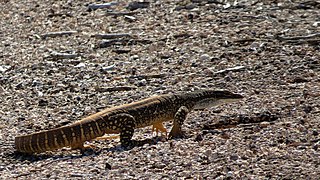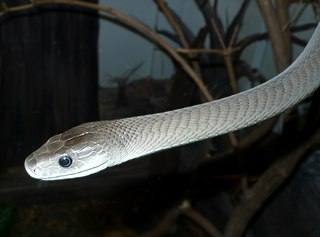
Snakes are elongated, limbless, carnivorous reptiles of the suborder Serpentes. Like all other squamates, snakes are ectothermic, amniote vertebrates covered in overlapping scales. Many species of snakes have skulls with several more joints than their lizard ancestors, enabling them to swallow prey much larger than their heads. To accommodate their narrow bodies, snakes' paired organs appear one in front of the other instead of side by side, and most have only one functional lung. Some species retain a pelvic girdle with a pair of vestigial claws on either side of the cloaca. Lizards have evolved elongate bodies without limbs or with greatly reduced limbs about twenty-five times independently via convergent evolution, leading to many lineages of legless lizards. These resemble snakes, but several common groups of legless lizards have eyelids and external ears, which snakes lack, although this rule is not universal.

Monitor lizards are large lizards in the genus Varanus. They are native to Africa, Asia, and Oceania, and one species is also found in the Americas as an invasive species. About 80 species are recognized.

A goanna is any one of several species of lizards of the genus Varanus found in Australia and Southeast Asia.

Ophiophagy is a specialized form of feeding or alimentary behavior of animals which hunt and eat snakes. There are ophiophagous mammals, birds, lizards, and even other snakes, such as the Central and South American mussuranas and the North American common kingsnake. The genus of the venomous king cobra is named for this habit.

Tiger snakes are a large and highly venomous snake of southern Australia, including its coastal islands and Tasmania. These snakes are often observered and locally well known by their banding, black and yellow like a tiger, although the species can be highly variable in coloration and patterning. All populations are classified within the genus Notechis (Elapidae), their diverse characteristics have been classified either as distinct species or by subspecies and regional variation.

The perentie is the largest monitor lizard or goanna native to Australia. It is the one of the largest living lizards on earth, after the Komodo dragon, Asian water monitor, crocodile monitor, and intersecting by size with Nile monitor. Found west of the Great Dividing Range in the arid areas of Australia, it is rarely seen, because of its shyness and the remoteness of much of its range from human habitation. The species is considered to be a least-concern species according to the International Union for Conservation of Nature.

The lace monitor or tree goanna is a member of the monitor lizard family native to eastern Australia. A large lizard, it can reach 2 metres (6.6 ft) in total length and 14 kilograms (31 lb) in weight. The lace monitor is considered to be a least-concern species according to the International Union for Conservation of Nature.

The sand goanna is a species of large Australian monitor lizard, also known as Gould's monitor, sand monitor, or racehorse goanna.

Venomous snakes are species of the suborder Serpentes that are capable of producing venom, which they use for killing prey, for defense, and to assist with digestion of their prey. The venom is typically delivered by injection using hollow or grooved fangs, although some venomous snakes lack well-developed fangs. Common venomous snakes include the families Elapidae, Viperidae, Atractaspididae, and some of the Colubridae. The toxicity of venom is mainly indicated by murine LD50, while multiple factors are considered to judge the potential danger to humans. Other important factors for risk assessment include the likelihood that a snake will bite, the quantity of venom delivered with the bite, the efficiency of the delivery mechanism, and the location of a bite on the body of the victim. Snake venom may have both neurotoxic and hemotoxic properties.
The Whowie, a fearsome creature from Australian Aboriginal mythology, resembled a seven-metre long goanna with a huge frog-shaped head and six powerful legs. He lived in a cave on the banks of the Murray River that extended deep beneath the ground, and his trampling on the riverbanks outside his cave formed the sandhills of the Riverina district. Although slow, the Whowie was extremely stealthy and could gobble up a whole tribe in a single meal.

The Australian Reptile Park is located at Somersby on the Central Coast, New South Wales in Australia. It is about 50 kilometres (31 mi) North of Sydney, and is just off the M1 Pacific Motorway. The Park has one of the largest reptile collections in Australia, with close to 50 species on display. The wide variety of reptile species at the Park includes snakes, lizards, turtles, tortoises, Komodo dragons, American alligators and crocodiles.

The lowland copperhead or lowlands copperhead is a venomous snake species in the family Elapidae, found in southeastern Australia and Tasmania. It is commonly referred to as the copperhead, but is not closely related to the American copperhead, Agkistrodon contortrix. If provoked, the lowland copperhead is a dangerous snake with neurotoxic venom, which can kill an adult human if correct first aid is not applied promptly.

Bothrops bilineatus, also known as the two-striped forest-pitviper, parrotsnake, Amazonian palm viper, or green jararaca, is a highly venomous species of pit viper found in the Amazon region of South America. Two subspecies are currently recognized, including the nominate subspecies described here. A pale green arboreal species that may reach 1 m (3.3 ft) in length, it is an important cause of snakebite throughout the entire Amazon region.
There are a vast array of myths surrounding the Blackfoot Native Americans as well as Aboriginal people. The Blackfeet inhabit the Great Plains, in the areas known as Alberta, Saskatchewan, and areas of Montana. These stories, myths, origins, and legends play a big role in their everyday life, such as their religion, their history, and their beliefs. Only the elders of the Blackfoot tribes are allowed to tell the tales, and are typically difficult to obtain because the elders of the tribes are often reluctant to tell them to strangers who are not of the tribe. People such as George B. Grinnell, John Maclean, D.C. Duvall, Clark Wissler, and James Willard Schultz were able to obtain and record a number of the stories that are told by the tribes.
The Jukambal were an indigenous Australian people located in northern New South Wales, Australia.











